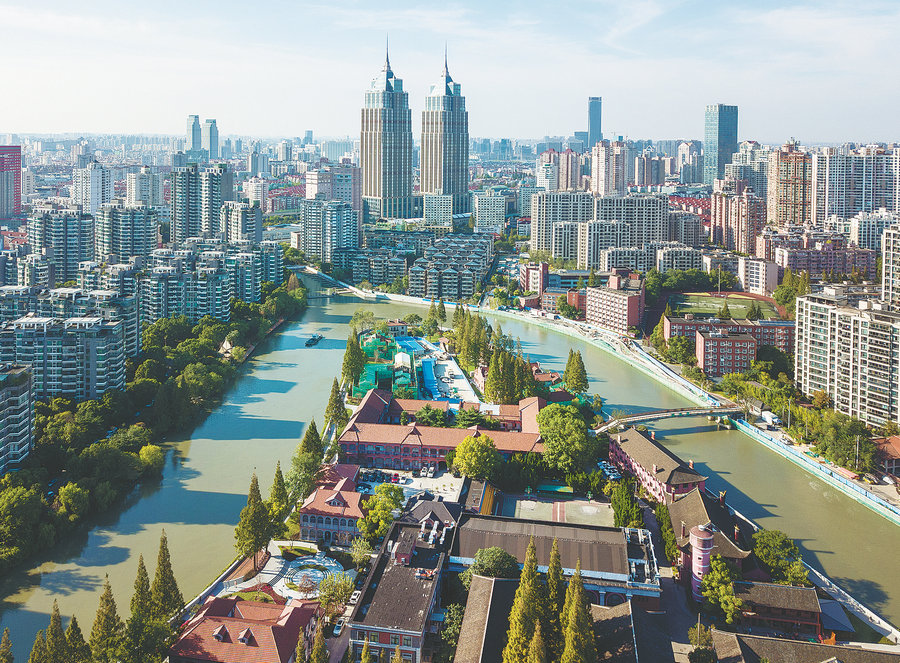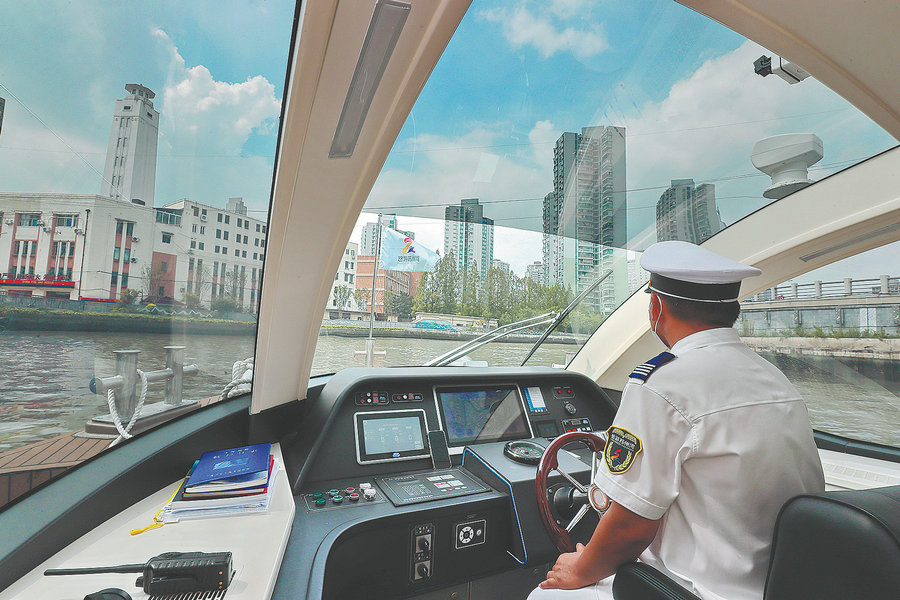
Boat tours give visitors a unique experience and close-up view as world-class attraction starts to take shape and city turns into a venue with sights to savor both on land and water, He Qi reports.
Think of the world-famous tourist cities that usually have a well-known waterfront where visitors can take in the view. For instance, the Hudson River in New York or the meandering Thames in London. Shanghai, with two rivers, is developing tourist water routes to Suzhou Creek, an important body of water zigzagging through the city and running into the Huangpu River on the Bund.
Marking the opening of the 2022 Shanghai Tourism Festival, Shanghai Administration of Culture and Tourism launched vessel tours of Suzhou Creek on Sept 17.
Four out of eight piers, where passengers can embark and disembark, have been put into trial operation.
The four piers connect the first phase of the operations from Changfeng Park in Putuo district to Waitanyuan in Huangpu and pass through Changhua Road pier in Putuo and Sihang Warehouse in Jing'an district.
The 17-kilometer journey lasts about two hours.
The remainder of the piers, Xikang Road, Mengqing Garden, Zhongshan Park, and Danba Road, will be put into use by the end of this year, the administration announced.
"Considering many factors, including the narrow channel, low bridges, many sharp turns and shallow water, the first batch of 12 will be put into operation," says Fang Shizhong, director of Shanghai Administration of Culture and Tourism.
Fang adds that the 12 vessels include six small-sized boats with open-top designs that are able to carry 11 passengers and six medium-sized ones with covering panoramic glass windows and toilets, carrying 20 passengers.
All the vessels will be put into operation by the end of this year.
"The reason why we want to highlight Suzhou Creek is to let everyone share the construction achievements of the people's city. In addition, it also draws on the development experience of global cities. The diversified functions and excellent ecology for Suzhou Creek make it highly suitable for building a world-class waterfront tourist area," says Fang.

As the section of the Wusong River entering the urban area of Shanghai, the 53-km-long Suzhou Creek has witnessed the development of the city for more than 100 years and plays an important role in urban construction.
The water quality of Suzhou Creek — so named because people used to travel on it to reach nearby Suzhou, Jiangsu province — was clear until the 1920s before industrialization along the banks resulted in domestic sewage and industrial waste water being discharged into it.
By 1930, the creek was no longer suitable as a source for tap water. By 1970, pollution had tainted the entire river.
The urban reaches were black and smelly while aquatic life had disappeared.
The creek has taken on an entirely new look in recent years since the city government started a comprehensive cleanup project since the mid-1990s.
With the treatment of water as well as the upgrading of riverside construction, the waterfront areas are now a popular destination for various sports, camping and picnics.
"Citizens once described Suzhou Creek very vividly. In the 1950s, it was for 'washing rice and vegetables'. In the 1980s, it ran 'out of fish and shrimp'. Now, it is 'beloved by everyone'," says Fang.
"We have the responsibility to let citizens and tourists see the clean water and appreciate the green environment along the creek, and to better taste the city's history and art," Fang says.
Fang adds that the administration has organized professional teams to conduct a general survey of tourism resources along Suzhou Creek since last year.
"We found that about 70 percent of the 205 tourism resources are high-quality, such as Sihang Warehouse, Zhapu Road Bridge and popular shopping mall 1000 Trees, and more than 90 cultural venues and landscape buildings. Meanwhile, five districts along Suzhou Creek have their own characteristics," he says.
Based on the research, the administration conducted the Overall Plan for Tourism Development of Suzhou Creek in Shanghai (2022-25). This aims to build the creek into a global landmark of urban waterfront tourism by the end of 2025.
The plan also clarified cooperation with waterfront accommodation, catering, entertainment and the performing arts to create urban leisure products, such as parent-child leisure, night markets and city tours.
At present, the Suzhou Creek routes are in an initial phase and the administration will conduct more function and safety tests during the trial operation.
It will present the services to the public at a proper time after sufficient adjustment and refinement based on the outcome of the trial operation.
According to Fang, three different routes will be put into operation by the end of this year, including a one-hour route that starts from Changfeng Park pier to Changhua Road pier, a loop route that passes through the historical landmarks, and chartered vessels that allow customers to design their own routes.
"In the future, we will offer regular passenger and all-pass tickets, and offer chartered boats while discovering more route operations so that citizens and tourists can not only travel by water but also walk on the banks," Fang says.














